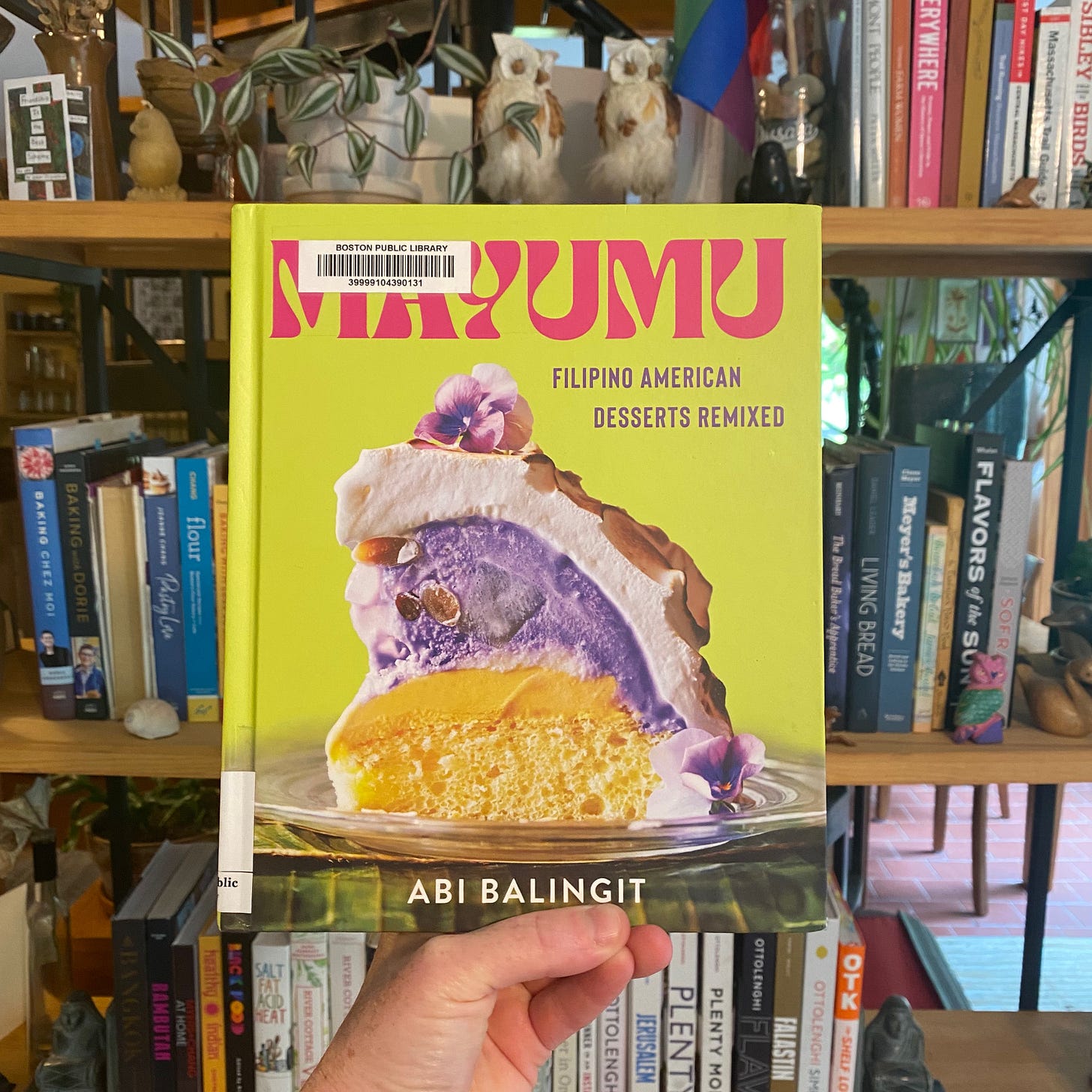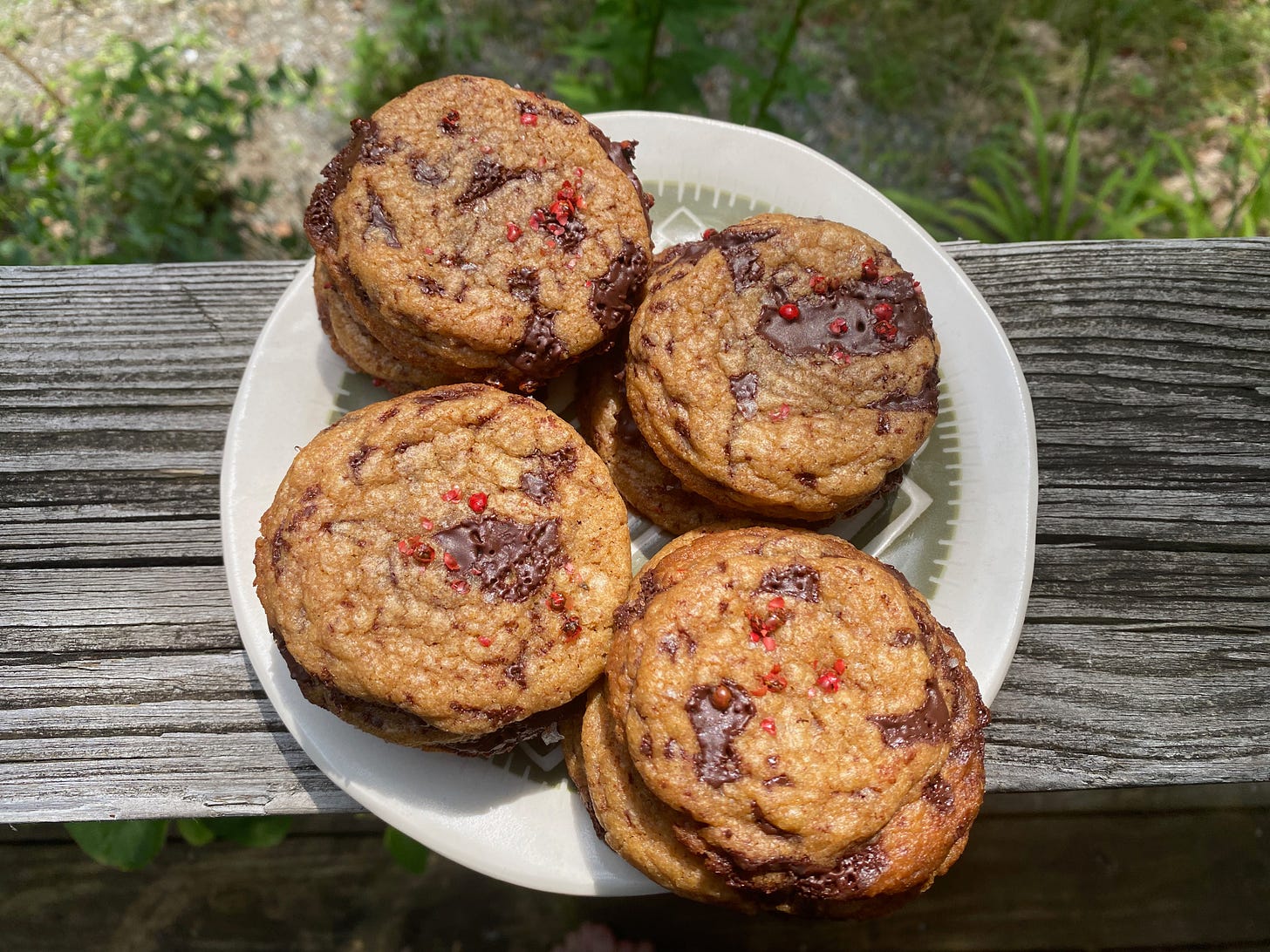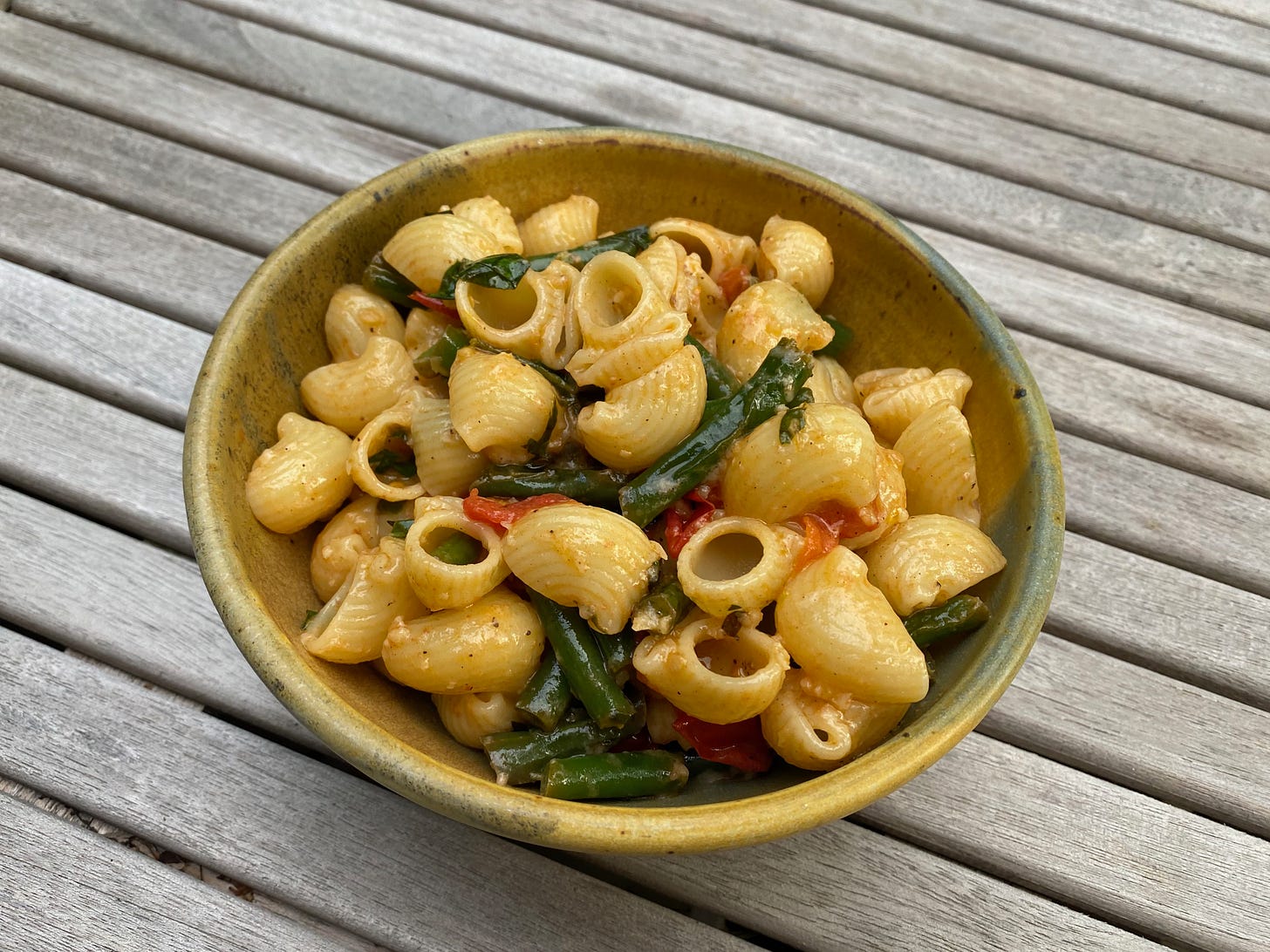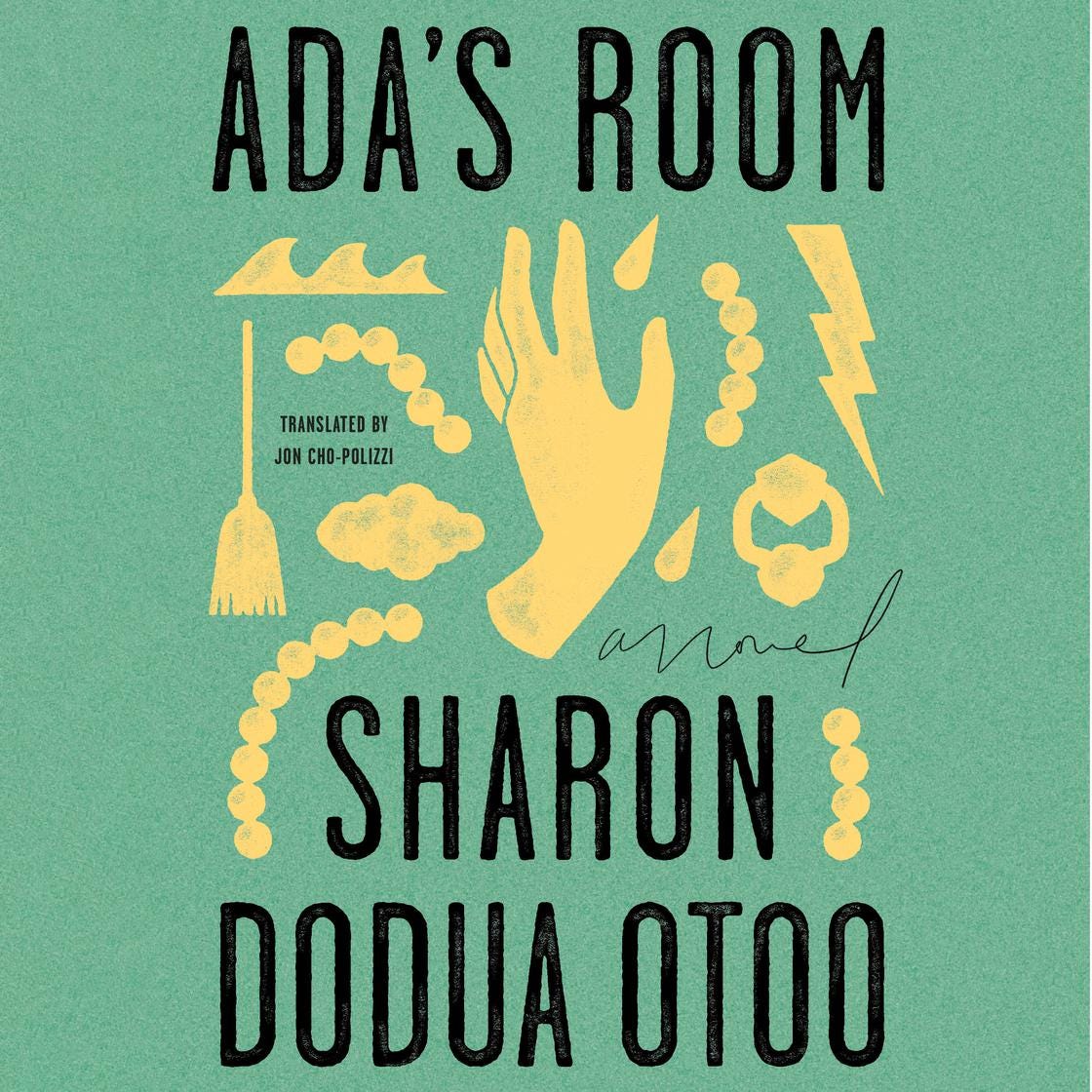Greetings, book and treat people!
On Monday morning, I drove 35 minutes to my new favorite lake for an early morning, before-work swim. I love a long morning swim in a deep lake or the ocean. I’ve been thinking about morning swims at Ashfield Lake since I went there for the first time a few weekends ago. Even so, for two weeks, I’ve been coming up with lists of reasons not to go: Driving 35 minutes to a lake is a whole production, a weekend adventure, not a regular Monday morning thing. I’ll have to change my whole morning routine to make time for it. It’ll make me late for the start of my day. Blah blah blah blah blah.
I didn’t even get up early on Monday. I walked my pup to the top of the hill. I brewed my tea, read my poetry, ate some granola, packed up my swimsuit and computer, and drove to the lake.
It was glorious. The cold, clear water, the glassy ripples. I met a group of women on their way back as I was swimming out to the middle of the lake. “Good morning,” they said, one after another. One paused to introduce herself. She told me about the kingfisher babies making a racket for food, and the bald eagle perched in a nearby cove. “Do you swim often?” she asked. I told her I did, but that it was my first morning swimming here. “Welcome to Ashfield,” she said. “Maybe I’ll see you tomorrow.”
I swam hard and long and then I floated on my back, out in the midst of all that stillness, face to the sky, water soothing across my skin. I swam back. I changed into my clothes on the empty beach, put on my earrings, drove to the library, and got to work.
We have so few days, and it’s so easy to convince ourselves they don’t matter. That driving a half hour on a weekday morning is an unnecessary extravagance. That going to the lake is a hassle. Instead of fiercely following our joy. Instead of taking the world’s proffered gifts, and opening them. I’m opening them. I hope you are, too.
As for this week’s books: I thoroughly enjoyed all of them, even though, for various reasons, I didn’t completely understand them. I’m thinking about what it means to ‘get something’ and whether it’s even a useful metric for reflecting on a reading experience. For months, I haven’t been able to shake this line from Cynthia Dewi Oka’s poetry collection A Tinderbox in Three Acts: "My resistance to narrative clarity has to do with failure to accept coherence as the best thing we have to offer each other.”
I’m not saying we shouldn’t reach for understanding, clarity, coherence. I just don’t think it’s the only thing we should reach for.
The Books
Flux by Jinwoo Chong (Speculative Fiction, 2023)
This is a very plotty time travel novel that deliciously blends genres—there are sci-fi and mystery elements, there’s a coming of age story, there’s family drama, there’s a strange and strangely compelling exploration of a fictional 1980s TV crime drama.
I read it in two days, and I liked it, but I didn’t love it. This is a me thing. Books like this, full of questions demanding answers, are hard for me to read. My brain wants so badly to slot everything into place, and that’s all I can think about. There are three intersecting timelines, and all are interesting. But I couldn’t settle into the underlying emotional resonance, the why behind the protagonist’s actions, all the beating heart human stuff that upholds the action and makes it meaningful.
I devoured the book, desperately following the twists of the plot, and while it does offer more resolution than, say, the nebulous anti-ending of Our Wives Under the Sea, it it was still unsatisfying—I got there and realized I didn’t have a real connection to the characters because I’d been so busy asking why? why? why?
There is a lot of emotional resonance, though. The main character is complicated and his actions do have whys. Chong writes about grief in a way that feels visceral—it’s upsetting and tangled and never quite lands where you think it’s going to land. This is not an empty novel, all plot, no depth. It asks a lot of questions about identity and memory: what makes us? Our memories? Our actions? And what shapes us? How does the way the world sees us change how we see ourselves? There is a lot here about Asian American and queer identity, responsibility and guilt, regret, hopelessness, media and pop culture, power and technology. The main character, at different times in his life, is driven and defined by all of these things and their messy intersections.
For me, all of these meaty questions and themes—and the main character’s continual tangling with them—were lost in the plot. This is why I rarely read thrillers and mysteries. Why can’t I let go of the puzzle pieces and just sink into whatever’s on the page, mysteries included? I’m so fascinated by my experience of books like this. I know that plots like this delight many people, and not only that, but lots of people have a directly opposite experience—a twisty plot becomes a doorway into character and theme. There’s no right way to read a book like this. But I do think it’s easy to conflate our own quirks and expectations and readerly desires with a book’s worth—and doing so doesn’t serve anyone.
On a Woman’s Madness by Astrid Roemer, tr. Lucy Scott (Fiction, 1982)
I did not read this book well. I kept starting and stopping, with days and days between, always lost when I returned to it, in place and time and heart. I finished it in one gulp because it’s was due back at the library, and gulping, became more lost, more tangled.
First published in Dutch in 1982, it has just been translated into English for the first time. Set in Suriname, it follows Noenka, a Black queer woman who, after leaving an abusive marriage, flees her small hometown and stitches together a life for herself in the capital. At least, that’s what it’s about on the surface, its bones stripped and bled down to a sentence. It’s hard to explain the wildness of the structure of this novel, the way it refuses ease and simplicity. It moves in every way a story can move, jumping from place to place, from past to present to future and back. It doesn’t stay in the same perspective, but moves between POVs in directions I’m still trying to untangle. A character begins a story and then story takes over the narrative. Sometimes the shifts are so subtle that I didn’t notice them until they were over.
Then there’s the interplay between dream-time and earth-time, between what’s happening in the mind and what’s happening in the body. I could not find the line between memory and action, vision and reality. Perhaps the line is there and I missed it, or perhaps there isn’t a line and that’s the point.
Reading this book, which I loved and struggled with, which felt like work and like a portal, I thought about all this queer joy and riotous pleasure, inked onto the page in 1982. I thought about the afterlives of slavery—a phrase, a truth, a tangle rattling around in my brain, even though I haven’t read all the work Kiki (@ifthisisparadise) has recommended on it yet. (The book at the top of my list is Runaway Genres: The Global Afterlives of Slavery by Yogita Goyal.)
I thought about what is survivable, what Noenka survives, and how she does so, with what words. I thought about how words work, and memory, and stories that slip in and out place, sense, dream, future, past. This passage has been echoing through me for weeks now:
We bury our dead within ourselves. We can also keep them alive. Everything that holds a place in our feelings stays alive. Everything we think of comes to life.
“Everything we think of comes to life.” That’s what reading this book feels like: everything coming to life. This, I think, is what makes it so compelling, even though I didn’t understand a lot of what happened, even though I didn’t read it well. The past is not past. The past as it pertains to this book—slavery, empire, colonial violence—keeps on growing. But, as Noenka says of the dead: “We can also keep them alive.” Stories of love and resistance, ancestral songs, earth-knowledge, little stones of delight and care—these also sprout from the past. What isn’t circular?
I didn’t get it, but I’m in awe of the brashness, the now-ness and then-ness and always-ness of this strange novel. I can’t wait to read it again.
The Mushroom at the End of the World by Anna Lowenhaupt Tsing (Nonfiction, 2015)
This is a fascinating, intricate, rangy, dense-but-beautiful book about matsutake mushrooms and the human and non-human ecosystems (natural, economic, social, cultural, historical, biological…) that surround them. It is about capitalism and living in it, with it, through it, and beyond it in complex ways. It moves from the disturbed forests of Oregon to Japanese markets. It is about ecosystems in Finland and the Cambodian genocide. It is about war refugees and the strangeness of commerce and fungal biology and logging and reforestation and. And.
There is so much going on in this book, and I didn’t slow down enough to take in. But I loved it wholeheartedly anyway. I want to make an argument for reading challenging books you don’t always understand. I want to make an argument for reading books you don’t get, even if, with enough time and study, you could get them. I could have read this book slowly and carefully, as if for a class, taking notes, rereading sections. I would have learned more from it. And: if I had forced myself to read it that way, I would not have read it. I am not in a time of life where I can read nonfiction that way. I am so grateful that I read it anyway. Every page was worth it.
I’ve only started reading nonfiction in the last six years. Part of this is because I started listening to audiobooks, which have opened up a whole world of books I’d never be able to get through in print. But it’s also because I’ve stopped treating every book of history or theory or philosophy like it’s a line on a college syllabus. I’m not afraid of what I don’t understand anymore. I read whatever fascinates me. I give it what I can, and I get out of it what I get out of it. I am a more thoughtful human because of this.
So here are some jumbled thoughts I thought as I meandered though this piece of art and scholarship:
We are all always in flux, and so are the systems we live in and build.
Yet another binary that makes little sense: the binary between human and non-human, natural and unnatural, wilderness and city. As if all of these things do not overlap in intense, scary, sacred, unexpected ways.
What happens when the protagonist of the story shifts—from human to mushroom, or forest? What histories and futures do we see differently when we tell them from a different POV?
Scent is absolutely wild.
Here’s a simple one that unravels into complexity the moment you tug: it’s all connected, and that means beauty is connected to capitalism, consumerism to culture.
Capitalist ruins, multispecies assemblages, salvage accumulation, forest time, translation: ideas I will be thinking about for a long time.
I’m excited to read more of Tsing’s work. Friction is next up on my list.
The Bake
For a while, I’ve been looking for ways to get excited again about this section of the newsletter—and baking itself. So I’m going to try something new and see how it feels! I’m going to focus on a new-to-me cookbook for about a month. I’ll try 3-4 recipes from it, share them with you, and then write up a mini review of the cookbook based on my experiences. I already have a list of cookbooks to check out from the library! If you have a favorite baking book, please let me know.
I’m starting with Mayumu: Filipino American Desserts Remixed by Abi Balingit. It was recommended by someone on Bookstagram, and if the first recipe is any indication of things to come, it’s going to be a winner.
Adobo Chocolate Chip Cookies
I decided to try something simple to start, and this recipe immediately caught my eye, because I love a chocolate chip cookie remix. Balingit is really into incorporating savory ingredients into desserts, and I am here for it. For these, she says she wanted to infuse the key flavors of adobo into a cookie. They have soy sauce, apple cider vinegar, and brown butter infused with bay leaves in the batter, along with dark brown sugar and chopped chocolate. They get sprinkled with crushed pink peppercorns and flaky sea salt.
Are these my new favorite cookie? Quite possibly. I cannot explain how good they are. They are sweet and caramely from the brown butter and brown sugar. The adobo ingredients give them a zesty, tangy, salty bite. The bay comes through as underlying earthiness. I love pink peppercorns and this is a perfect way to use them. There’s this complex, savory flavor in these cookies that I don’t know how to describe expect to say it’s amazing and it doesn’t overpower the sweetness at all.
I was, shockingly, out of regular soy sauce when I made these, so I used sweet soy sauce instead, which is thicker and sweeter. I’m excited to try them with regular soy sauce, too! I also used toasted sugar in place of white sugar, which I always recommend. Balingit says the recipe makes 22 cookies, but even though I made mine much smaller than she sugggests, I got 32, and I baked them for few extra minutes as well.
Verdict: 11/10. No notes.
The Bowl & The Beat
The Bowl: Buttery Pasta with Beans and Tomatoes
I’ve made this for dinner twice in the past week. The first time I just wanted something quick and filling, and what I had around was green beans. The second time I was craving it. This is one of those meals that’s better than it should be. The secret: lots of butter and lots of Parmesan.
Trim some green beans and cut them into smallish pieces (maybe thirds). Toss them in a skillet with a lot of butter—half a stick. Add pressed garlic, a whole lot, five or six cloves at least. Cook over medium heat until the beans are just starting to soften. Add a handful of halved cherry tomatoes or other small tomatoes, along with salt and pepper and the zest and juice from one lemon. You can add some more butter, too. Give everything a good stir, turn off the heat, and then grate a ton of Parmesan right into the pan, at least half a cup. Probably more. You can’t have too much. Stir to distribute all that wonderful, melty Parmesan, and then toss with your favorite pasta. Garnish with chopped basil or another herb you love. And more Parmesan.
The Beat: Ada’s Room by Sharon Dodua Otoo, tr. by Jon Cho-Polizzi, read by Cyril Nri & Debbie Korley
I didn’t plan it, but this audiobook fits perfectly into this week’s theme. I do not get it. I have no idea what’s happening. In this case, it’s mostly my own fault: audio isn’t the best format for me to absorb this story. There are lots of characters with the same name (Ada), as well as at lest one divine and/or supernatural and/or immortal being. They all take turns narrating, jumping from 15th century West Africa to Victorian London to Germany at the end of World War II to contemporary Berlin. I think there are a lot of interesting and complicated things going on, a lot of nuanced ideas about history and linear time and womanhood and what connects us—but I am just lost. I should have switched from audio to print, but I didn’t. I might revisit it one day.
The Bookshelf
Around the Internet
On AudioFile, I wrote about books that embrace the messy middle. For Book Riot, I rounded up some of my favorite under-the-radar queer books from the first half of the year. I also made a list of indie bookstores with amazing websites for browsing. You’re welcome.
Queer Your Year
I’m taking a break from giving recommendations in every newsletter. However, if you’re stuck on a prompt, you can always email me and I’ll happily suggest some books. You can also come ask the fantastic folks in the Queer Your Year discord!
My new library has a circulating zine collection and it’s my favorite, favorite thing. You can now browse the whole collection on the CW MARS website, and, if you’re local to Western Mass, check some out! What does any of this have to do with Queer Your Year? The Queer Your Year Reading Challenge Zine is officially part of the collection!
The Boost
It’s been a few weeks since the fires on Maui. Here are some resources for ways to help:
Two Hawai’i-raised friends have compiled a comprehensive document that includes a list of ways to donate. You can access it at this link.
Though it’s also in the above document, here is a list of fundraisers for families in need.
This is a mutual aid initiative started by Lahaina residents for Lahaina residents affected by the fires. You can donate directly to families via their Instagram page.
I also want to share a fundraiser for the family of my friend and Book Riot colleague Connie Pan, who lost their homes in the fires.
As always, a little bit of beauty to send you on your way: It’s all about bodies of water for me right now. I spent last Saturday afternoon at the most magical waterfall in Vermont. I am in continual awe of the shapes water makes.
Catch you next week, bookish friends! Next week’s newsletter will be a special edition for all subscribers about The Sealey Challenge! But, as always, if you want to support my work, you can subscribe here.











Im so into this argument for reading things we don’t get and without college level note taking or prescribing not letting ourselves finish the book until we do “get it.” I love letting stuff wash over me and absorb what clicks and letting whatever else pass me by. Maybe I’ll grab it or have space those concepts some other way, some other time. I’ve in the past felt silly or not my smartest at these moments but you made it all sound deep and intentional and I’m here for that!
I was so moved by your sharing the experience of getting to ashfield lake on a weekday. I felt it in my body, heart and soul! I’ve always tried to fit that joy into my life. I can’t wait to get there myself!